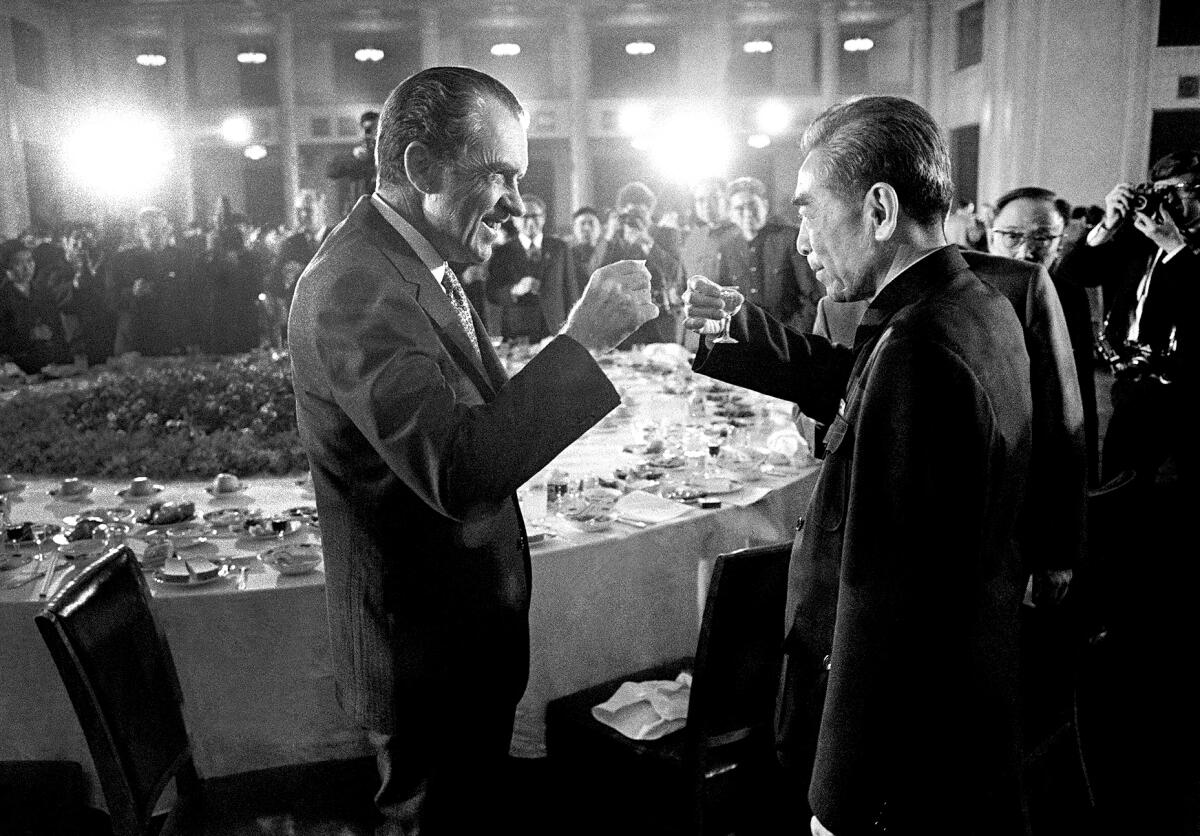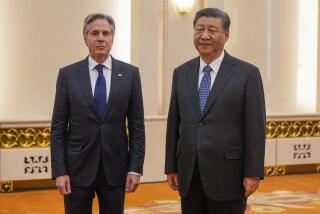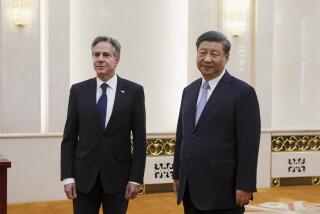Op-Ed: How Nixon’s fabled trip to China, 50 years ago this week, led to today’s Taiwan crisis

- Share via
Fifty years ago today, President Nixon landed in Beijing for the historic weeklong trip that effectively ended the United States’ long isolation from the People’s Republic of China.
He settled into the Chinese State Guest House, where each day he scribbled down notes for a series of meetings with Chinese Premier Zhou Enlai.
“Taiwan = Vietnam = trade-off,” Nixon wrote at one point, outlining his thinking. “[Taiwan’s] status is determined — one China, Taiwan is part of China. [We] won’t support Taiwan independence.”
For decades, all that was known about Nixon’s “opening to China” in February 1972 was a sanitized version based largely on the memoirs of the former president and, particularly, Henry Kissinger, his national security advisor.
Even high school students are familiar with the heroic narrative: Only Nixon, the inveterate anti-communist, could have “gone to China.” Nixon and Kissinger skillfully played “the China card” against the Soviet Union. And the two men merely brought U.S. policy in line with reality when they bypassed claims that Chiang Kai-shek’s Nationalists, exiled on Taiwan, represented the rightful government of China.
There are elements of truth in the tale, but it leaves out a lot.
For example, on the “only Nixon” argument: Democratic Sens. Mike Mansfield and Ted Kennedy had also been seeking to go to Beijing; Nixon and Kissinger asked the Chinese not to let them in. On the “China card,” it can be argued that in reality Beijing played an “American card” against the Soviet Union, which had been skirmishing with China along their shared border.
And then there is Taiwan.
In the carefully fudged Nixon-Kissinger formulation, the two Americans gave away little as regards the island, only the fictitious claims of Chiang and the Nationalists. In reality, they gave quite a bit more. Indeed, in today’s ongoing tensions between the U.S. and China over Taiwan, we are all living with the consequences of the framework they constructed 50 years ago.
As Georgetown University diplomatic historian Nancy Bernkopf Tucker concluded when transcripts of the talks were declassified: “Nixon and Kissinger wanted so intensely to realize their goal that they surrendered more than was necessary to achieve it, and the price was paid, not in the near term by the Nixon White House, but over the long term by the people of Taiwan and by U.S. diplomacy writ large…. The president and his national security advisor viewed Taiwan as expendable.”
What Nixon and Kissinger hoped to get from China was help in ending the Vietnam War — that is, help in persuading North Vietnam to make a peace settlement.
Ahead of the trip, Nixon had written to himself: “What they want: 1) Build up their world credentials. 2) Taiwan. 3) Get U.S. out of Asia. What we want: 1) Indochina? 2) Communists — to restrain Chicom expansion in Asia. 3) In Future — Reduce threat of a confrontation by Chinese Super Power.”
In other words, Vietnam (“Indochina”) was at the very top of Nixon’s list.
As for Taiwan, two questions were being hashed out. The first involved Chiang’s claims to govern mainland China. The second was the future of the island. It had been occupied by Chiang’s troops at the end of the Chinese civil war, but most of the island’s inhabitants did not come from the mainland. Indeed, at the time of Nixon’s trip, there was a growing movement among native Taiwanese for independence from Chiang’s occupying forces.
Nixon and Kissinger were focused — and they kept the attention of the American press and public focused — almost entirely on the first issue: Who ruled the mainland? But much of the clandestine diplomacy surrounding Nixon’s trip involved the other question, the future of Taiwan. That was the priority for Mao Zedong, the chairman of the Chinese Communist Party, and Zhou.
America’s formal, long-standing position had been that Taiwan’s status was “undetermined.” But without saying so in public, the U.S. had begun to back away from that position during Kissinger’s preliminary trip to Beijing in July 1971.
What Kissinger had secretly pledged then was that the United States would not support independence for Taiwan. John Holdridge, a senior staff member on the National Security Council who was on the 1971 trip, later recounted that Kissinger “finally said what I had written for him on no two Chinas; no one China, one Taiwan; no independent Taiwan.”
Meanwhile, Kissinger and Nixon pushed China for its help on Vietnam. Again, the crucial details are left out of their memoirs, but they can be found in a U.S. intelligence study of American diplomacy with China that was released as the result of a Freedom of Information lawsuit in 1994.
On Feb. 6, 1972, a little more than two weeks before Nixon was to arrive in Shanghai, Nixon and Kissinger proposed that China arrange a secret sidebar during the trip, a meeting with Le Duc Tho, North Vietnam’s peace negotiator. China sent back word that it supported North Vietnam and would not be drawn into its negotiations with the United States.
China’s refusal didn’t change Nixon’s calculus on Taiwan. Transcripts of his first session with Zhou include this promise to the Chinese leader: “We have not and will not support any Taiwan independence movement.”
Kissinger, meanwhile, during late-night negotiations over what a final communique would say, agreed to this language: “The United States acknowledges that all Chinese on either side of the Taiwan Strait maintain there is but one China and Taiwan is part of China.”
When they were shown the draft, senior State Department officials, who had been cut out of Kissinger’s negotiations, furiously posed last-minute objections. They pointed out that many people born on Taiwan did not agree that Taiwan was part of China. They wanted the phrase “all Chinese” taken out and replaced by just “Chinese.”
Kissinger went back into late-night negotiations and tried to get the wording changed, but Chinese officials held firm, and the eventual Shanghai Communique, signed at the end of Nixon’s trip, contains the language Kissinger first agreed to. Taiwan’s native population and their desires got no mention in the communique. To Nixon and Kissinger, “Taiwan” meant simply Chiang Kai-shek’s government.
Defenders of the 1972 negotiations have argued that they allowed the island to develop and prosper on its own for half a century. But Nixon and Kissinger would have been amazed to know Taiwan would survive separately from China for as long as it has.
What is often called the Taiwan crisis these days began 50 years ago. It is the underside of Nixon’s heralded trip, the legacy of deals made in secret about the future of millions of Taiwanese and their relationship to the People’s Republic of China.
James Mann, a former Los Angeles Times staff writer, is a fellow at Johns Hopkins School of Advanced International Studies and the author of “About Face: A History of America’s Curious Relationship With China, From Nixon to Clinton.”
More to Read
A cure for the common opinion
Get thought-provoking perspectives with our weekly newsletter.
You may occasionally receive promotional content from the Los Angeles Times.










